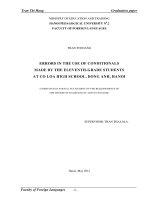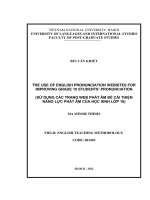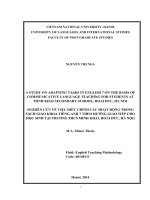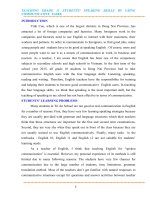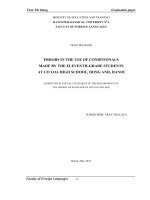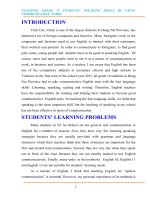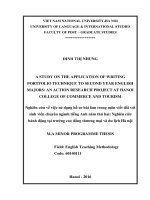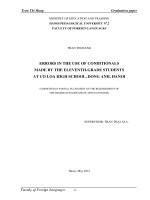Improving grade 10 students’ writing ability by using written corrective feedback an action research project at tien phong high school, me linh, ha noi
Bạn đang xem bản rút gọn của tài liệu. Xem và tải ngay bản đầy đủ của tài liệu tại đây (1.63 MB, 83 trang )
VIETNAM NATIONAL UNIVERSITY, HA NOI
UNIVERSITY OF LANGUAGES AND INTERNATIONAL STUDIES
FACULTY OF POST-GRADUATE STUDIES
HOÀNG THỊ DUYÊN
IMPROVING GRADE 10 STUDENTS’ WRITING ABILITY BY
USING WRITTEN CORRECTIVE FEEDBACK: AN ACTION
RESEARCH PROJECT AT TIEN PHONG HIGH SCHOOL,
ME LINH, HA NOI
(CẢI THIỆN KHẢ NĂNG VIẾT CHO HỌC SINH LỚP 10 BẰNG VIỆC CHỮA
LỖI DƯỚI HÌNH THỨC VIẾT: NGHIÊN CỨU HÀNH ĐỘNG TẠI TRƯỜNG
THPT TIỀN PHONG, MÊ LINH, HÀ NỘI)
Hanoi - 2017
VIETNAM NATIONAL UNIVERSITY, HA NOI
UNIVERSITY OF LANGUAGES AND INTERNATIONAL STUDIES
FACULTY OF POST-GRADUATE STUDIES
HOÀNG THỊ DUYÊN
IMPROVING GRADE 10 STUDENTS’ WRITING ABILITY BY
USING WRITTEN CORRECTIVE FEEDBACK: AN ACTION
RESEARCH PROJECT AT TIEN PHONG HIGH SCHOOL,
ME LINH, HA NOI
(CẢI THIỆN KHẢ NĂNG VIẾT CHO HỌC SINH LỚP 10 BẰNG VIỆC CHỮA
LỖI DƯỚI HÌNH THỨC VIẾT: NGHIÊN CỨU HÀNH ĐỘNG TẠI TRƯỜNG
THPT TIỀN PHONG, MÊ LINH, HÀ NỘI)
M.A Minor Programme Thesis
Field: English Language Teaching Methodology
Code: 60140111
Hoàng Thị Xuân Hoa. Ph.D
Hanoi – 2017
CERTIFICATE OF ORIGINALITY OF PROJECT REPORT
I certify my authority of the Study Project Report submitted entitled
Improving grade 10 students’ writing ability by using written corrective
feedback: An action research project at Tien Phong high school, Me Linh, Ha
Noi
in fulfillment of the requirements for the degree Master of Arts
Hanoi, January 2017
Hoang Thi Duyen
i
ACKNOWLEDGEMENTS
First and foremost, I would like to register my profound gratitude to
Ms. Hoang Thi Xuan Hoa, my respected supervisor, for her invaluable instruction,
contribution and great care to my research.
I wish to take this opportunity to express my heartfelt thanks to the teachers
of Department of Post - Graduate Studies who have supplied me with the good
conditions to conduct this thesis and finish this M.A course.
My thanks go to my managers at Tien Phong high school, my colleagues for
their assistance, encouragement during the time I participated in M.A course.
Also, I owe my debt to my students who are the subjects of my thesis for
their willingness to answer my questionnaires, interviews.
Lastly, I am also grateful to my families for their kindly encouragement during
the research’s finalization.
ii
ABSTRACT
Many language educators and researchers (e.g., Nunan; 1987; Horwitz, 1988;
Schulz, 2001) claim that matching the expectations of teachers and students is
important for successful language learning. Therefore, it is important for teachers to
be aware of the impact of their corrective feedback practices on students’
expectations and writing accuracy. Accordingly, this study is an attempt to find
ways to improve writing skill by investigating the effect of some types of written
corrective feedback on writing performance and the students’ attitudes towards
teachers’ corrective feedback at Tien Phong High school. The participants included
35 students from grade 10. The data were collected from survey questionnaires for
students, the direct interview with nine students and students’ written work. The
results show that teacher’s written corrective feedback helps improve students’
writing ability. However, there is a slight mismatch between teachers’ beliefs and
students’ preferences for teacher corrective feedback regarding feedback types and
forms. On this basis, the study recommends a number of directions for teachers to
help them improve their feedback practices more effectively.
iii
TABLE OF CONTENTS
CERTIFICATE OF ORIGINALITY OF PROJECT REPORT......................... i
ACKNOWLEDGEMENTS ..................................................................................... ii
TABLE OF CONTENTS ................................................................................................ iv
CHAPTER 1: INTRODUCTION ............................................................................1
1.1. Identification of the problem .................................................................................... 1
1.2. Aims of the study and research questions................................................................ 2
1.3. Scope of the study ........................................................................................................ 3
1.4. Significance of the study............................................................................................ 3
1.5. Methods of the study ................................................................................................... 3
1.6. Organization of the paper ........................................................................................... 3
CHAPTER 2: LITERATURE REVIEW ...............................................................5
2.1. Major approaches to teaching writing ....................................................................... 5
2.1.1. The product approach ........................................................................................5
2.1.2. The process writing approach ...........................................................................5
2.2. Definition of writing ability....................................................................................... 6
2.2.1. Writing ability implied in product/text-oriented approach ...............................6
2.2.2. Writing ability implied in process/cognitive-oriented approach .....................7
2.2.3. Writing ability implied in reader/genre-oriented approach ..............................7
2.3. Definition of corrective feedback ............................................................................. 8
2.4. Forms of feedback ...................................................................................................... 9
2.4.1. Oral feedback ....................................................................................................9
2.4.2. Written feedback .............................................................................................10
2.5. Types of corrective feedback to students’ writing ................................................. 10
2.5.1. Peer feedback ..................................................................................................11
2.5.2. Teacher’s feedback..........................................................................................12
2.6. Teachers' written corrective feedback strategies ................................................... 13
2.6.1. Teacher direct corrective feedback .................................................................14
2.6.2. Teacher indirect corrective feedback ..............................................................15
iv
2.6.3. Teacher metalinguistic corrective feedback ....................................................15
2.6.4. Previous studies on teacher’s written corrective feedback .............................15
2.7. Different views about the roles of teacher written corrective feedback ............. 18
2.7.1. Arguments for the role of teacher written corrective feedback ......................19
2.7.2. Arguments against the role of teacher written corrective feedback ....................20
2.8. Factors affecting the effectiveness of written corrective feedback ..................... 21
28.1. Nature of errors ................................................................................................21
2.8.2. Student factors .................................................................................................22
2.8.3. Teacher factors ................................................................................................23
2.8.4. Contextual variables ........................................................................................24
CHAPTER 3: METHOD AND PROCEDURE....................................................26
3.1. Overview of action research ..................................................................................... 26
Figure 3.1: Steps in the action research cycle ................................................................ 27
3.2. Research setting ......................................................................................................... 27
3.2.1. The school .......................................................................................................27
3.2.2. Participants .....................................................................................................28
3.2.3. The research procedures ..................................................................................29
3.2.4. Data collection instruments. ............................................................................33
3.2.5. Data analysis ...................................................................................................34
3.3. Summary ..................................................................................................................... 34
CHAPTER 4 RESEARCH FINDINGS AND DISCUSSION .............................35
4.1. Effects of three common types of feedback on students’ writing performance. 35
4.1.1. Effects of three common types of feedback on students’ revised writing papers........35
4.1.2. The effects of three common types of feedback on students’ new writing
exercises. ..................................................................................................................37
4.1.3. Discussion .......................................................................................................41
4.2. Students’ opinions towards different types of corrective feedback and their
preference each type of teacher corrective feedback. ................................................... 44
4.2.1. Students’ opinions towards teacher corrective feedback in general. .............44
v
4.2.2. Students’ preference for each type of teacher corrective feedback. ...............45
4.2.3. Students’ expectations for better use of teacher corrective feedback. ............48
4.3. Reflection .................................................................................................................... 49
For more effective use of teacher written corrective feedback, teachers and students
should bear the following suggestions in mind. ............................................................ 50
CHAPTER 5: CONCLUSION ...............................................................................53
5.1. Summary of the main findings ................................................................................. 53
5.2. Limitations of the study ............................................................................................ 54
5.3. Suggestions for further study. .................................................................................. 54
REFERENCES ..........................................................................................................55
APPENDIX A
vi
LIST OF FIGURES AND TABLES
Table 2.1: Ellis’ typology of feedback types (2009 p.98) ......................................... 13
Figure 3.1: Steps in the action research cycle ........................................................... 27
Table 3.1: Timetable of the action implementation .................................................. 30
Figure 4.1: Effects of three common types of feedback on students’ revised writing
exercises .................................................................................................................... 35
Figure 4.2: Taxonomy of errors and their frequency in Stage 1 ............................... 38
Figure 4.3: Taxonomy of errors and their frequency in Stage 2 ............................... 39
Figure 4.4: Taxonomy of errors and their frequency in Stage 3 ............................... 40
Figure 4.5: Students’ attitudes towards the use of teacher written corrective
feedback .................................................................................................................... 45
vii
CHAPTER 1: INTRODUCTION
1.1.
Identification of the problem
Nowadays, English is considered to be one of the key factors that help our
country make faster progress on the way of industrialization and modernization. As
a result, the English language has rapidly become the most popular first foreign
language among Vietnamese people, especially at schools, colleges and universities.
For learners of English, the English language surely brings about a better career
prospect, so the demand to use English fluently as well as to master the four basic
skills is becoming essential among all students.
Of the four main skills, listening, speaking, reading and writing, writing is the
most difficult and least preferable skill to be learnt, because it needs hard thinking
in producing words, sentences, and paragraph at the same time. According to
Richards, J. C., & Renandya, W. A. (2002), “writing is the most difficult skill for
second language learners to master. The difficulty lies not only in generating and
organizing ideas, but also in translating these ideas into readable text.” Writing,
undeniably, is amongst the most prominent skills that language learners need to
learn as an essential component of their academic practice and later on in their
professional life. Therefore, helping students enhance their writing skills is one of
the teachers’ responsibilities and desirability. This partially explains why teaching
writing has prompted a great deal of research that covers various aspects of its
broad instructional contexts. The literature review reveals that the effects of teacher
written corrective feedback on students’ writing
remain to be inconclusive.
However, numerous studies on the use of corrective feedback in writing classes
have shown that written corrective feedback can be applied in writing classes to
improve students’ writing accuracy (Liu, 2008; Kaweera, 2008; Ferris, 2000; Ferris
et al., 2001).
It is obvious that one of the most meaningful and important methods of teaching
writing is the use of written corrective feedback because it allows teacher-to-student
1
interaction in the second language writing class (Ferris, Pezone, Tade, & Tinti,
1997). Many L2 writing teachers feel that written corrective feedback is influential
in the improvement of their students' L2 writing accuracy (Brown, 2007; Hyland &
Hyland, 2006). Raimes (1983, p.139) also notes, “Responding to students’ writing
is very much a part of the process of teaching writing”. (Ferris & Roberts, 2001;
Lee, 2004; Brown, 2007). That means corrective feedback is very necessary for the
success of the writing tasks.
In my own teaching experience, I have found out that most students find
themselves uncomfortable during the writing lessons and they are unsatisfied with
their writing ability. As a result, they are reluctant to write and always find
themselves unprepared for the task of writing.
Aware of the importance of teaching writing skill, I, myself, always try my best
to make the writing lessons more interesting by applying various teaching
approaches, adapting textbooks to make the lessons more suitable for the students to
learn. However, my efforts seem not effective at all, the student cannot improve
their writing competence. For all the aforementioned reasons, I think that it would
be necessary to have an investigation into teacher’s written corrective feedback and
students’ perception of those corrective feedback so I wish to conduct a study
entitled “Improving grade 10 students’ writing ability by using written corrective
feedback: An action research project at Tien Phong high school, Me Linh, Ha Noi”
1.2. Aims of the study and research questions
This research is designed to investigate the effectiveness of written corrective
feedback on improving students’ writing performance. It also investigates the students’
opinions of the types of written corrective feedback they get from their teachers.
In order to achieve those aims, the research attempts to answer the following
questions:
1.
To what extent do students improve their writing ability after receiving
written corrective feedback?
2.
What are the students’ opinions about their teacher’s feedback types?
2
1.3. Scope of the study
Corrective feedback
in writing can be provided by any reader of a
composition such as peers, friends or instructors and can be given in both oral and
written forms. However, within the framework of a minor thesis, this study focuses
only on the types of written feedback provided by teachers in language classrooms.
In addition, due to the limited scope of this study, the participants selected are
only students from the class that I directly teach.
1.4. Significance of the study
The study proves that written corrective feedback is crucial to the
teaching and learning of writing. Written corrective feedback offers a number
of advantages. It gives both the readers and the writers more opportunities for
collaboration, consideration and reflection than oral negotiation and debate. It also
gives the teacher a better chance of closely following the progress of individuals
and groups, both in terms of the feedback offered and revisions made.
1.5. Methods of the study
This study was implemented with the hope to improve the students’ English
writing skills, two methods were used in order to obtain adequate information for
the study. They were document analysis and action research which is aimed at
improving a situation. After carrying out a preliminary investigation, a writing
instruction course was designed, and different types of teacher written corrective
feedback were applied. The data were collected by the analysis of students’ writing
and students’ survey questionnaires, interviews. Students’ writings were collected
and analyzed before, during and after treatment period (i.e. the delivery of
feedback) to measure the students’ progress in their writing performance. In
addition, students’ survey questionnaires, interviews were collected and analyzed at the
end of the research to find out their attitudes towards each feedback type and its effects.
1.6. Organization of the paper
The paper consists of five chapters as follows:
Chapter 1 – Introduction – briefly states the rationale of the study, the aims,
research questions, scope as well as the significance and organization of the study.
3
Chapter 2 – Literature review - discusses the literature related to the written
corrective feedback to students’ writing, different views and types of written
corrective feedback in writing.
Chapter 3- Methodology and procudure - describes the current situation of
the teaching and learning writing at Tien Phong high school and the methodology
which deals with the participants, instrumentation, data collection procedure and
data analysis procedure.
Chapter 4 – Research findings and DiscussionThe last chapter – Chapter 5 – Conclusion - summarizes the major findings of the study,
acknowledges its limitations and provides suggestions for further study.
4
CHAPTER 2: LITERATURE REVIEW
To provide a theoretical background to the study, this part is devoted to the
review of concepts that are the most relevant to the thesis’ topic. It begins with the
two major approaches to teaching writing then the definition of writing ability.
Next, it comes to some theoretical backgrounds to teacher’s written corrective
feedback which consists of definitions of feedback, purposes of giving feedback,
some different types of written corrective feedback as well as different views on
written corrective feedback. It ends with some factors affecting the effectiveness of
written corrective feedback.
2.1. Major approaches to teaching writing
There have been two main class methodologies: the product approach and the
process approach respectively. Although some writing schemes and programs have
tended to rely largely or exclusively on one or other of these approaches, in practice
most teachers and text book writers have drawn on more than one and have
combined and modified them to suit their purpose. In recent years, class teaching
method has been heavily influenced by the communicative approach, with its
emphasis or task-oriented activities that involves the exchange of information and
the free use of language without undue concern for mistakes.
2.1.1. The product approach
There are different approaches to teaching writing. One of the earliest
approaches is product-based approach in which as stated by Tangpermpoon (2008),
students will start from pre-writing to composing and to correcting. In this approach
what is emphasized is raising students’ awareness, especially in grammatical
structures. According to Nunan (1999), in this approach the focus is on the final
product which should be a coherent, error-free text and students will initiate, copy
and transform models provided by textbooks or by teachers.
2.1.2. The process writing approach
Nunan (1991) clearly states that the process approach focuses on the steps
5
involved in creating a piece of work and the process writing allows for the fact that
no text can be perfect, but that a writer will get closer to perfection by producing,
reflecting on, discussing and reworking successive drafts of a text. Fowler (1989)
acknowledges that process writing evolved as a reaction to the product approach, in
that it met the need to match the writing processes inherent in writing in one’s
mother tongue, and consequently allow learners to express themselves better as
individuals. Hyland (2003) defines process writing as the process which students
write following a model specified by the instructor. Emphasis shifts from the nature
of the final product, to the process used to create the final product.
2.2. Definition of writing ability
According to Stephen P. Witte, Neil Nakadate and Roger D. Cherry (1992)
writing ability as a critical theoretical construct has too often been defined largely
by the testing industry as whatever a particular writing test measures. In other
words, writing ability has traditionally been defined by test of writing.
Yi, Jyi-yeon. (2009) stated that the definition of writing ability can be formed
depending on the teachers’ own experience as teachers. It can be also defined
according to their ideology on writing. Ideology means here teacher’s philosophy
on the nature of writing. Writing ability may also be formed according to
pedagogical approaches to the teaching of writing. As there are various pedagogical
approaches to the teaching of writing, there is more than one definition of writing
ability that could be generally accepted amongst teachers and researchers of writing.
Also, Yi, Jyi-yeon. (2009) said that approaches themselves are classified
differently according to researchers. It seems, however, that they can be reduced
into three main approaches: product/text-oriented, process/cognitive-oriented and
reader/genreoriented.
2.2.1. Writing ability implied in product/text-oriented approach
For teachers and researchers who subscribe to the view of "Texts-asautonomous objects", writing ability is defined as the ability to respond to a given
stimulus according to some authority’s definition of the correct response (Nunan,
6
1999). Put another way, it is "the ability to adhere to style-guide prescriptions
concerning grammar, arrangement and punctuation" (Nunan, 1999, p.59), regardless
of audience, purpose or context, working on the assumption that a text can mean the
same thing to all people only if it is written explicitly following the given
prescriptions (Hyland, 2002).
According to the "Text-as-discourse" view, writing ability is the ability to create
coherent and cohesive discourses following prescribed patterns for developing and
organising discourse.
To sum up, both of these frameworks view writing ability as the capacity to
produce "acontextually" (Hyland, 2002, p.6) correct forms of language, following
prescribed patterns at either sentence or discourse level.
2.2.2. Writing ability implied in process/cognitive-oriented approach
This approach centres on
what the writer does during writing. Commonly
known as the Process approach (Johns, 1990; Nunan, 1999; Raimes, 1983; Silva,
1990; Tribble, 1996), it can be roughly divided into three subcategories:
Expressivist, Cognitivist and Social (Situated) strands (Grabe & Kaplan, 1996;
Hyland, 2002; Johns, 1990).
From Expressivist view, as Grabe and Kaplan (1996) note, learners are
encouraged to look for their own authentic voices and freely express them.
Accordingly, the writing activities employed by those subscribing to this view are
likely to be personal essays and journal writing, which are suitable for selfdiscovery (Johns, 1990). From this position, writing ability can be defined as the
ability to express oneself freely.
Yi, Jyi-yeon. (2009) noted that writing ability in this process/cognitive-oriented
approach is, therefore, defined as the ability to initiate and evolve ideas and then use
certain revising and editing practices to develop them to maturity in a given context.
2.2.3. Writing ability implied in reader/genre-oriented approach
According to Yi, Jyi-yeon. (2009), this Genre-based approach, which
emphasises awareness of the reader, regards successful writers as those who are
7
able to make reasonable assumptions about what the reader knows and expects, seek
a balance between their writing purpose and the reader’s expectations, and satisfy
the reader’s rhetorical demands. Thus, according to this approach, writing ability is
defined as the ability to perform writing tasks for a given purpose, satisfy a given
discourse community with regard to the structure and content of the discourse, and
communicate functionally.
According to Common European Framework for Reference (CEFR) at B1
level students can write simple texts on topic which are familiar or of personal
interest by linking a series of shorter discrete elements into a linear sequence. They
can write personal letters describing events, experiences and impressions.
2.3. Definition of corrective feedback
Various researchers define the term “feedback” in different ways, among which
the one put forward by Keh is one of the most comprehensive. Keh (1989, p.24)
considers feedback as “any input from a reader to a writer with the effect of
providing information to the writer for revision”. Lightbown and Spada (1999,
p.172) states that feedback is “an indication to the learner that his or her use the
target languages is incorrect”.
Raimes (1983, p.139) notes, “Responding to
students’ writing is very much a part of the process of teaching writing”. That
means feedback is very necessary for the success of the writing tasks.
Teacher feedback, is this sense, can be regarded as an effective means to
communicate to students about their writing so that they can enhance their
composition.
Corrective feedback refers to the response that second language students
receive on the errors that they make in their oral or written production. (Sheen, Y. &
Ellis, R. 2011). Feedback, as viewed by Furnborough and Truman (2009), involves
the existence of gaps between what has been learned and the target competence of
the learners and the efforts undertaken to bridge the gaps. This feedback is provided
to ask for further information, to give directions, suggestion for revision, and to give
positive feedback about what the students have done well (Ferris, 1997).
8
When reviewing their students’ writing, second language teachers give feedback
on a wide range of issues. They may address the text’s content, the way in which
the ideas are organized, the choice of vocabulary that is used. The type of feedback
that has attracted numerous researchers’ attention, however, is feedback on
linguistic errors. Such responses have widely been referred to as “corrective
feedback” or “error correction”. Yeh and Lo (2009) defines corrective feedback as
the responses to the texts containing errors. They also claim that corrective feedback
supplies students with direct or indirect responses about what is unacceptable. The
responses can be an indication where the errors are, what types of errors those
belong to; a provision of correct form of the target language; metalinguistic
information about the errors or any combination of these. Yeh and Lo (2009)’s
definition seems to be the most suitable and closely involves in the scope of this
study. Therefore, this definition is adapted in this study.
2.4. Forms of feedback
Basing on forms, feedback is distinguished as two main types which are oral
feedback and written feedback. Comparing between these two types, written form is
more common but it is a fairly traditional and time-consuming method to give
feedback on various drafts of a student paper. Both of these two forms are
recommended to be considered.
2.4.1. Oral feedback
When discussing oral feedback in the classroom, any kind of dialogue that
provides information that will help students improve their learning can be included.
Sinclair and Coulthard state that, “A typical exchange in the classroom consists of
an initiation by the teacher, followed by a response from the pupil, followed by
feedback, to the pupil’s response from the teacher[…]” (1992:3). This is a typical
interaction that takes place in a classroom. Oral feedback is therefore a natural part
of verbal interaction between students and teachers, or students and students. Oral
feedback is mostly considered to happen between a teacher and a student, but some
researchers (Yang, Badger and Yu, 2006) note that a great deal of verbal feedback
9
also comes from peers. Hattie and Gan (2011:260-263) explain that oral feedback
can be group-focused or more individual-focused feedback. So-called corrective
feedback happens when the teacher collects the most common mistakes and corrects
them in class so as not to single out any individual student; this could be considered
to be more group-focused oral feedback. For instance, Yuen Kwong (2001:1-4)
states that even though feedback can be provided individually, it is more efficient if
the whole class is involved so that students can learn from each other’s mistakes.
This study limits itself to the exploration of written corrective feedback only.
2.4.2. Written feedback
In contrast to oral feedback, which is natural part of a classroom setting and
happens naturally, written feedback is sometimes considered as optional because it
is slightly different from oral feedback in that it requires written comments and a
correction of a different kind. Written feedback involves feedback given to
students’ written work. This type of feedback is usually not immediate and the
teacher has time to think about how to give feedback and on what. Therefore, there
are different strategies used when providing students with written feedback. For
instance, a teacher can provide feedback that is related to the content and the
organization of the writing, as well as to the grammar and vocabulary (Weigle
2002). According to Weigle (2002), the purpose of teachers’ feedback lies in
providing guidance in writing.
Written feedback is an integral aspect of any English language course. This is
especially true now with the predominance of the process approach to writing that
requires some kinds of instructors’ feedback on students’ drafts. This form of
feedback can be also divided into several different subtypes.
2.5. Types of corrective feedback to students’ writing
Written corrective feedback can be provided by any reader of a composition,
such as peers or friends, but is generally provided by instructors in most language
classrooms. In a foreign language context, “teacher response and evaluation are
typically the principal means by which the second language learners measure their
progress as writers” (Hedgcock & Lefkowitz, 1996, p. 1).
10
2.5.1. Peer feedback
Peer feedback is a practice in language education where feedback is given by
one student to another. According to Bartels (2004), peer feedback means feedback
from the fellow students. If students are working on the same assignment together,
peer feedback means exchanging drafts and comments on each other’s drafts.
Peer feedback is used in writing classes to provide students more opportunities
to learn from each other. Peer feedback broadens learners’ involvement by giving
them the additional roles of reader and advisor to go with that of writer. Further,
structuring face-to-face discussion into the feedback process provides students the
opportunity to engage in constructive controversy, which may lead to insights and
greater task engagement (Johnson & Johnson, 1987).
Some of the research on peer feedback has found that it has social and cognitive
advantages; for example, through using their peers' comments in re-drafting,
students can improve their revision and produce better drafts (e.g. Mendonca and
Johnson, 1994; Rollinson, 2005; Villamail and de Guerrero, 1996). Also, from a
socio-cognitive point of view, peer feedback is a "formative developmental process"
(Hyland and Hyland, 2006:6), which means that writers develop the ability to
exchange views on how they interpret the writings of other students and how other
students interpret their writing. Other studies, however, have either raised more
research questions on peer feedback (e.g. Connor and Asenavage, 1994) or found it
of limited use (e.g. Flower, 1994; Spear, 1988).
Ferris and Hedgcock (1998:170-171) also provide an outline of the advantages of
peer feedback, for example that peer feedback gives students the ability to a) play
an active role in learning writing (Mendonca and Johnson, 1994), b) use their peers'
ideas to redraft their writings (Mendonca and Johnson, 1994), c) receive reactions
from an authentic audience (Mittan, 1989), d) receive more than one point of view
about their writing from different peer groups (Chaudrun, 1983; Mittan, 1989), e)
receive clear and direct feedback from their about what they have done well and
what they still have to improve (Mittan, 1989; Moore, 1986; Witbeck, 1976), f)
11
improve their critical and analytical skills through responding to peers' writing
(Leki, 1990a; Mittan, 1989) and g) develop self-confidence by comparing their own
abilities to their peers' strengths and weaknesses (Leki, 1990a; Mittan, 1989).
However, there are still some problems in the use of peer feedback. One of the
major problems is that the quality of the responses is questioned. Students often feel
that their peers offer unspecific, unhelpful and even incorrect feedback because they
lack the knowledge of the target language or the knowledge in certain specific
content areas. Other concerns about peer feedback are raised by Amores (1997),
who argues that students may find it difficult to accept criticism from their peers
and may respond defensively to their feedback.
2.5.2. Teacher’s feedback
In the light of process writing approach, teachers play an important role in
helping students to revise their writing drafts. Teacher’s corrective feedback, to
some extent, is the teacher's correction and can be defined as teachers' indication to
learners' errors, which takes the forms of implicit or explicit correction.
Written corrective feedback refers to teacher written feedback on a student’s essay
with an aim of improving grammatical accuracy (including spelling, capitalization,
and punctuation) as well as idiomatic usage (such as word order and word choice).
The primary of this thesis is meant to be an investigation into how the different
teacher written corrective feedback strategies improve
students’ writing
performance.
Some researchers indicate that students favor corrective feedback from teachers
because they believe that they will benefit greatly from it (Leki, 1990). Studies by
Ashwell (2000), and Ferris (2003) conclude that there is a positive correlation
between student
writing accuracy and teacher corrective feedback. Furthermore,
Ellis (1998) and Lightbown (1998) state that thanks to teacher corrective feedback
adult learners can avoid fossilization and maintain their progress in their second
language proficiency.
12
2.6. Teachers' written corrective feedback strategies
Although the provision of written corrective feedback has long been deemed
integral to second language/foreign instruction programs, it has not always been
provided in the same manner. There are different classifications for corrective
feedback strategies proposed by different researches.
Ellis (2009) presents a typology which consists of six main strategies to provide
corrective feedback (see Table 2.1).
.
Table 2.1: Ellis’ typology of feedback types (2009 p.98)
Types of CF
Description
A. Strategies for
providing CF
1. Direct CF
The teacher provides students with
the correct form.
2. Indirect CF
The teacher indicates that an error
exists but does not provide the
correction.
a. Indicating + This takes the form of underlining
locating
the and the uses of cursors to show
error
omissions in the students’ text.
Studies
e.g. Lalande(1982) and Robb
et al.(1986)
Various
studies
have
employed indirect correction
of this kind (e.g. Ferris and
Roberts
2001;
Chandler
2003).
b.
Indication This takes the form of an Fewer studies have employed
only
indication in the margin that an this method (e.g. Robb et al.
error or errors have taken place in 1986).
a line of text.
3. Metalinguistic The teacher provides some kind of
CF
metalinguistic clue as to nature of
the error.
a. Use of error Teacher writes code in the margin Various
studies
have
code
(e.g. ww = wrong word; art = examined the effects of using
article).
codes (e.g. Lalande 1982;
Ferris and Roberts 2001;
Chadler 2003).
b.Brief
Teacher numbers errors in text and Sheen (2007) compared the
grammatical
writes a grammatical description effects of direct CF and direct
descriptions
for each numbered error at the CF + metalinguistic CF
bottom of the text
13
4. The focus of This concerns whether the teacher
the feedback
attempts to correct all (or most) of
the students’ errors or selects one
or two specific types of errors to
correct. This distinction can be
applied to each of above options.
a. Unfocused
CF
b. Focused CF
Most
studies
have
investigated unfocused CF
(e.g. Chandler 2003; Ferris
2006). Sheen (2007), drawing
on traditions in SLA studies
of CF, investigated focused
CF
Unfocused CF in extensive
Focused CF is intensive
5.
Electronic The teacher indicates an error and
feedback
provides a hyperlink to a
concordance file that provides
examples of correct usage.
6.
This consists of a native speaker’s
Reformulation
reworking of the students’ entire
text to make the language seem as
native-like as possible while
keeping the content of the origi nal
intact.
Milton (2006)
Sachs and Polio (2007)
compared the effects of direct
correction and reformulation
on students’ revisions of their
text.
Ellis, Loewen and Erlam (2006) categorize responses from teachers to students’
error into three forms or strategies: (1) teacher feedback that indicates that an error
has been made, (2) teacher feedback that provides the correct form of the target
language, and (3) teacher feedback that provides the metalinguistic information
about the nature of the error. This current research adapts this categorization
together with Ellis’ typology of written corrective feedback in that the focus of this
research was how and whether students’ writing performance could be improved via
the 3 main types of written corrective feedback strategies, namely direct, indirect,
metalinguistic corrective feedback.
2.6.1. Teacher direct corrective feedback
In the case of direct corrective feedback, the teacher gives the corrected form of
the mistake to the students. Direct feedback may be done in various ways such as by
striking out an incorrect or unnecessary word, phrase, or morpheme, inserting a missing
or expected word, phrase or morpheme; and by providing the correct linguistic form
above, in the margin or near the erroneous form (Ellis, 2008; Ferris, 2006).
14
2.6.2. Teacher indirect corrective feedback
Indirect written corrective feedback refers to situations when the teacher
indicates that an error has been made but does not provide a correction, thereby
leaving the student to diagnose and correct it. This can be done by underlying or
circling errors, recording in the margin the number of errors in a given line,
confirmation checks, and request for clarification. (Bitchener, 2008).
2.6.3. Teacher metalinguistic corrective feedback
Metalinguistic feedback could take one of two forms. Use of error coding or a
brief grammatical description. In the former type, the teacher writes some codes in
the margin to suggest what problem learners have. Of course, the learners will have
a list of codes to avoid confusion. However, in the second type of metalinguistic
feedback, the teacher numbers the errors and briefly provides a brief explanation for
the error at the end of the text.
2.6.4. Previous studies on teacher’s written corrective feedback
A number of previous studies have proved the revision effect of direct feedback.
Chandler’s (2003) suggests that direct correction works best for producing accurate
revisions. This type of corrective feedback is desirable for students of low level of
proficiency who are unable to self-correct and do not know what the correct form
might be. However, it requires minimal processing on the part of the learners and
thus, it may not contribute to long-term learning (Ellis, 2009). In addition, a recent
study by Sheen (2007) suggests that direct corrective feedback can be effective in
promoting acquisition of only specific grammatical features. This finding is in line
with the study of Van Beuningen, Dejong and Kuiken (2012) which claims that
“Direct correction is better suited for grammatical errors and indirect correction is
better suited for non-grammatical errors”.
Another advocate of direct written corrective feedback has also suggested that it
may be more beneficial because it “reduces confusion” (Chandler, 2003), supplies
students with information to “resolve more complex errors” and is “more
immediate”. Therefore, direct written corrective feedback may be more useful for
learners who have comparatively limited linguistic knowledge.
15
Lee (2005) adds that direct feedback may be appropriate for beginner students, or in
a situation when errors are “untreatable” that are not susceptible to self-correction
such as sentence structure and word choice, and when teachers want to direct
students’ attention to error patterns that require student correction.
Advocates of indirect written corrective feedback (e.g., Ferris, 1999, 2006) claim
that it may foster deeper language processing by requiring the student to engage in
“guided learning and problem solving”, leading to reflection about linguistic forms
that may foster long-term acquisition. Thus, although indirect corrective feedback
does not have immediate revision effect, it leads to long-term learning and has more
benefits than direct feedback on students’ long-term development and acquisition
especially for more advanced students (Ferris and Roberts, 2001). Therefore it is
suggested that indirect corrective feedback, by requiring the students to determined
the correct form of the mistake on his own, may be more useful for learners at
higher proficiency levels as they have relatively advanced linguistic knowledge.
Ferris (2002), Ferris and Roberts (2001) observe that while direct feedback led to
greater accuracy in text revisions, indirect feedback results in the production of
fewer initial errors over time. Bitchener et al (2005), Bitchener and Knoch (2010)
point out that complex errors might not be good targets for indirect feedback since
learners are often not capable of self-correcting the identified errors. Additionally,
for features about which students already have some explicit knowledge, indirect
corrective feedback can assist them in the transition from declarative to procedural
knowledge (Lyster, 2004).
However, the results of studies that have investigated the difference between
direct and indirect are very mixed. Some studies (e.g., Ferris & Helt, 2000) showed
that indirect feedback is indeed more effective in enabling students to correct their
errors. Lalande (1982, p.140) recommends that indirect feedback consistently calls
errors to students’ attention, triggering the “guided learning and problem-solving”
processes. By contrast, Frantzen, (1995) found no difference between direct and
indirect corrective feedback.
16
